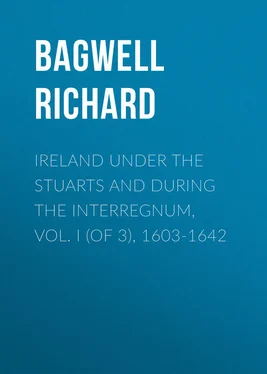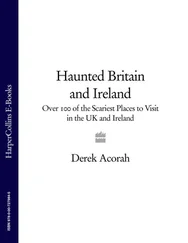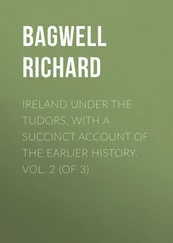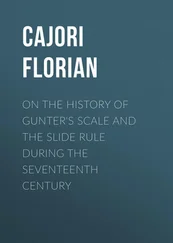Richard Bagwell - Ireland under the Stuarts and during the Interregnum, Vol. I (of 3), 1603-1642
Здесь есть возможность читать онлайн «Richard Bagwell - Ireland under the Stuarts and during the Interregnum, Vol. I (of 3), 1603-1642» — ознакомительный отрывок электронной книги совершенно бесплатно, а после прочтения отрывка купить полную версию. В некоторых случаях можно слушать аудио, скачать через торрент в формате fb2 и присутствует краткое содержание. Жанр: foreign_antique, foreign_prose, на английском языке. Описание произведения, (предисловие) а так же отзывы посетителей доступны на портале библиотеки ЛибКат.
- Название:Ireland under the Stuarts and during the Interregnum, Vol. I (of 3), 1603-1642
- Автор:
- Жанр:
- Год:неизвестен
- ISBN:нет данных
- Рейтинг книги:4 / 5. Голосов: 1
-
Избранное:Добавить в избранное
- Отзывы:
-
Ваша оценка:
- 80
- 1
- 2
- 3
- 4
- 5
Ireland under the Stuarts and during the Interregnum, Vol. I (of 3), 1603-1642: краткое содержание, описание и аннотация
Предлагаем к чтению аннотацию, описание, краткое содержание или предисловие (зависит от того, что написал сам автор книги «Ireland under the Stuarts and during the Interregnum, Vol. I (of 3), 1603-1642»). Если вы не нашли необходимую информацию о книге — напишите в комментариях, мы постараемся отыскать её.
Ireland under the Stuarts and during the Interregnum, Vol. I (of 3), 1603-1642 — читать онлайн ознакомительный отрывок
Ниже представлен текст книги, разбитый по страницам. Система сохранения места последней прочитанной страницы, позволяет с удобством читать онлайн бесплатно книгу «Ireland under the Stuarts and during the Interregnum, Vol. I (of 3), 1603-1642», без необходимости каждый раз заново искать на чём Вы остановились. Поставьте закладку, и сможете в любой момент перейти на страницу, на которой закончили чтение.
Интервал:
Закладка:
Mass was now openly celebrated, the churches reconsecrated in the recorder’s presence, and the Ten Commandments in the cathedral scraped out so as to make some old pictures visible. The town was full of priests and friars, one of whom claimed legatine authority, and ‘they had the cross carried like a standard before them throughout the streets,’ every one being forced to reverence it. It was openly preached that James was no perfect king until he had been confirmed by the Pope, and that the Infanta’s title was in any case better. Gradually these tumultuary proceedings ripened into open insurrection, and 200 young men in two companies were ordered to be armed and maintained by the citizens. It was indeed proposed to arm the whole population from twelve to twenty-four years, but there was not time for this. Lieutenant Christopher Murrough, who had served the League in France, was active during the whole disturbance. The mayor, who vacillated between expressions of loyalty and acts of disrespect to the new sovereign, had evidently the idea of a free city in his head, and said he was ‘like the slavish Duke of Venice and could not rule the multitude.’ 9 9 Brief Relation in Carew , 1603, No. 5; Irish State Papers calendared from April 20 to May 14; Lismore Papers , 2nd series, i. 43-73; Mountjoy to the Mayor of Cork, May 4, in Cox , p. 7. The full account in Smith’s Cork is mainly founded on the Lismore collection. Lady Carew’s letter of May 5, 1603, among the State Papers and Lady Boyle’s of March 18, 1609, in the Lismore Papers are both printed verbatim, and are interesting to compare as specimens of ladies’ composition.
‘I myself,’ says an eye-witness, ‘saw in Cork on Good Friday a procession wherein priests and friars came out of Christ’s Church with the mayor and aldermen, and best of citizens going along the streets from gate to gate all singing, and about forty young men counterfeiting to whip themselves. I must needs say counterfeiting because I saw them (although bare-footed and bare-legged), yet their breeches and doublets were upon them, and over that again fair white sheets, everyone having a counterfeit whip in his hand – I say a counterfeit whip because they are made of little white sticks, everyone having four or five strings of soft white leather neither twisted nor knotted – and always as their chief priest ended some verses which he sung in Latin these counterfeits would answer miserere mei , and therewith lay about their shoulders, sides, and backs with those counterfeit whips; but I never saw one drop of blood drawn, therefore their superstition is far worse than the Spaniards’, who do use such whipping upon their bare skin, that the blood doth follow in abundance, which they do in a blind zeal, and yet it is far better than those counterfeits did.’ 10 10 Farmer’s Chronicle in MS. Harl. 3544. Farmer was a surgeon.
Cork was then a walled town, but being commanded by high ground can never have been strong. Outside the south gate and bridge and not far from where the Passage railway station now stands Carew had begun to build a fort with the double object of overawing the town and of intercepting a foreign enemy. After the battle of Kinsale the work had been discontinued, and no guns were mounted. The north gate was commanded by Shandon Castle, which was in safe hands. The east and west sides of the city were bounded by the river, which ran among marshy islands. The approach from the open sea was partly protected by a fort on Haulbowline Island, at the point where the Lee begins finally to widen out into the great harbour, and the seditious citizens had visions of destroying this stronghold, which the recorder pronounced useless and hurtful to the corporation. Inside the town and near the north gate was an old tower known as Skiddy’s Castle, used as a magazine for ammunition and provisions. The citizens refused to allow stores to be carried out to the soldiers and at the same time obliged them to remain outside. One alleged grievance was that two guns belonging to the corporation were detained at Haulbowline, and Thornton against Boyle’s advice exchanged them for two in the town which belonged to the King. Lieutenant Murrough was placed in charge of Skiddy’s Castle, every Englishman’s house was searched for powder, ‘a priest being forward in each of these several searches,’ and the inmates expected a general massacre. Sir George Thornton left the town, Lady Carew took refuge in Shandon, and Lord Thomond’s company was sent for. Wilmot arrived with his men when the disturbances had lasted for more than a week, but the townsmen would not listen to reason, and began to demolish Carew’s unfinished fort. The recorder admitted that he had instigated this act of violence. Wilmot took forcible possession of the work, but forbade firing into the town on pain of death. The inhabitants then broke out into open war, sent round shot through the Bishop’s palace where the Commissioners lodged, and killed a clergyman who was walking past. They severely cannonaded Shandon, but, as Lady Carew reported, ‘never did any harm to wall or creature in it,’ and did not frighten her in the least.
On May 5 Thornton brought up a piece of Spanish artillery from Haulbowline, and when three or four shots had pierced houses inside the walls, a truce was made. Five days later Mountjoy arrived. 11 11 Authorities last quoted.
The question of a legal toleration for the Roman Catholics and of municipal freedom for the town had been carefully mixed up together, and the possession of all Government stores by the citizens made the rising troublesome for the moment if not actually formidable. The chief commissary, Mr. Allen Apsley, was the mayor’s prisoner from April 28 to May 10, and his evidence fortunately exists. First there was an attempt to get the troops out of the neighbourhood by refusing provisions which were undoubtedly the King’s property. At last it was agreed that the stores should be removed by water to Kinsale, but the opportunity was taken to extort an extravagant freight, and when the vessel was laden she was not allowed to leave the quay. After Wilmot’s arrival on April 20 or 21, it was pretended that he wished to get possession of the town by treachery, and the mayor said he was ‘as good a man and as good a gentleman as Sir Charles Wilmot, if the King would but knight him, and give him 200 men in pay, and the like idle comparisons.’ Four days later this valiant doge had guns mounted on the gates, and the provisions and powder were disembarked again. The mayor first tried to make Apsley swear to answer all his questions, and on his refusal confined him to his own house. Two days later the recorder put him into the common gaol, and bail was refused. There seems to have been an attempt to make out that Apsley had committed treason by helping Wilmot to get possession of the stores, but of this even there was no proof. 12 12 Apsley’s account in Lismore Papers , 2nd series, i. 66.
Meade and his party strongly urged that Mountjoy should be forcibly resisted, but more prudent counsels prevailed, and the town had to receive a garrison of 1,000 men. The chief points having been occupied by his soldiers, the Lord Deputy entered by the north gate, and saw ploughs ranged on both sides of the street as if to show that the extortion of the soldiers had made the land lie idle. The old leaguer Murrough, a schoolmaster named Owen MacRedmond, who had openly maintained the Infanta’s title, and William Bowler, a brogue-maker, were hanged by martial law. The recorder, who had land, was reserved for trial, and was ultimately acquitted by a jury at Youghal, though he was undoubtedly guilty of treason by levying war. The foreman was fined 200 l. and the rest 100 l. apiece, but it became evident that no verdict could be expected in any case where matters of religion might be supposed in question. Meade went abroad and remained in the Spanish dominions for many years. He is heard of at Naples, too poor to buy clothes for a servant, but in 1607 he was at Barcelona and receiving a pension of 11 l. per month. In 1611 he wrote a letter of advice to the Catholics of Munster, grounded on the Act 2 Eliz., chap. 2, in which he showed that they were not bound to go to church, but the attempt to enforce attendance had then been practically abandoned. 13 13 Notices of Meade in the Calendars of State Papers, Ireland , especially No. 355 of 1611, where his tract is entered as among the Cotton MSS. There is another copy in the Bodleian, Laudian MSS. Misc. 612, f. 143. The proceedings at Meade’s trial are calendared under 1603, No. 184.
Интервал:
Закладка:
Похожие книги на «Ireland under the Stuarts and during the Interregnum, Vol. I (of 3), 1603-1642»
Представляем Вашему вниманию похожие книги на «Ireland under the Stuarts and during the Interregnum, Vol. I (of 3), 1603-1642» списком для выбора. Мы отобрали схожую по названию и смыслу литературу в надежде предоставить читателям больше вариантов отыскать новые, интересные, ещё непрочитанные произведения.
Обсуждение, отзывы о книге «Ireland under the Stuarts and during the Interregnum, Vol. I (of 3), 1603-1642» и просто собственные мнения читателей. Оставьте ваши комментарии, напишите, что Вы думаете о произведении, его смысле или главных героях. Укажите что конкретно понравилось, а что нет, и почему Вы так считаете.












